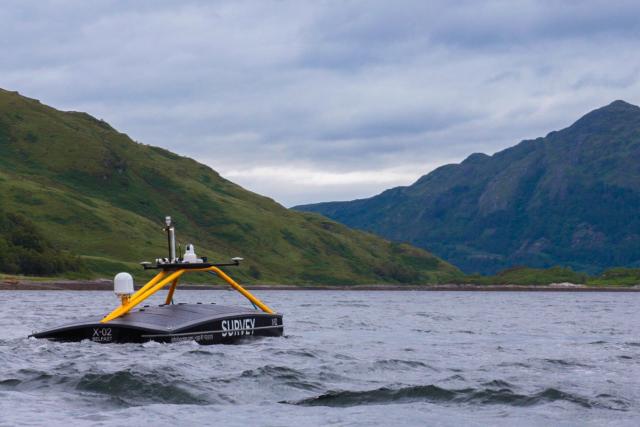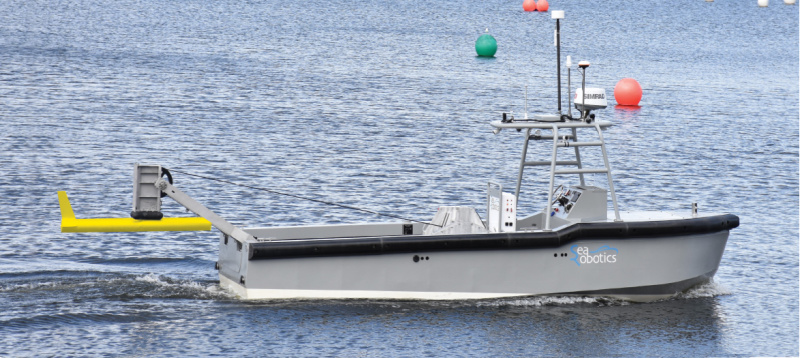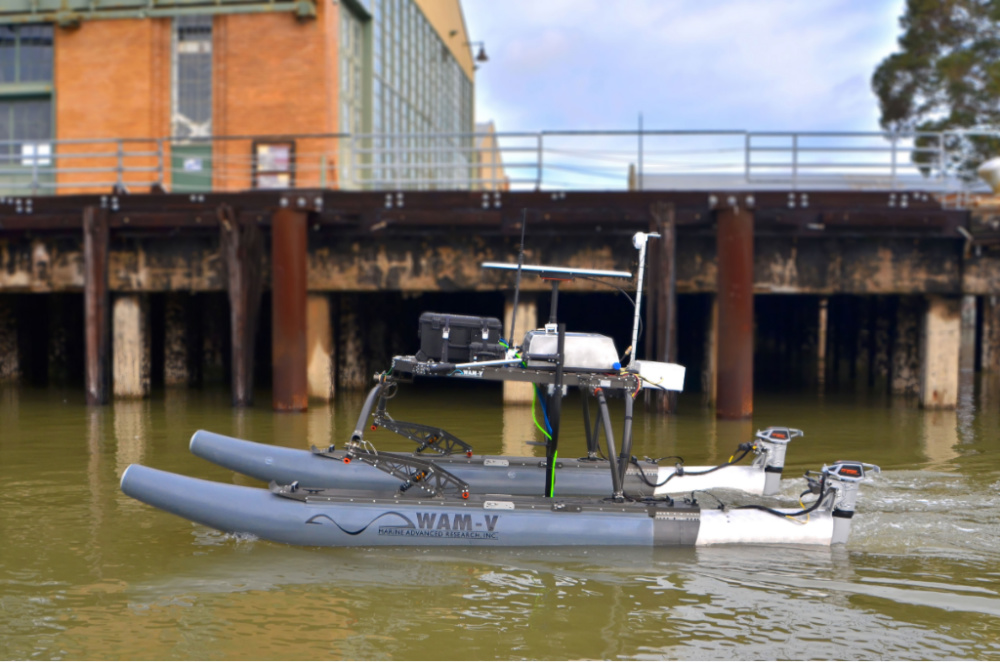
The Torqeedo-powered XOCEAN XO-450 electric USV is underway in Scottish waters. Using USVs, XOCEAN offers turnkey data collection services to surveyors, companies and agencies. Its platform operates 24/7, accelerating project delivery. Note, XOCEAN is not a survey company; it is a data collection service provider to surveyors, companies and agencies. XOCEAN customers include BP, Shell, Total, Seadrill and other offshore oil/gas companies. (Source: Torqeedo)
Increasingly, builders and operators of unmanned survey vessels (USVs) are turning to electric propulsion as a sustainable alternative to fuel-burning engines.
There are several reasons: electric motors are inherently more efficient than internal combustion engines; with no fuel consumption, operating and maintenance costs are lower; and electric power eliminates the need to carry highly flammable gasoline on board. They are also quieter—an important consideration when performing underwater acoustic surveys—and produce zero emissions running on electric power.
Electric propulsion technology has come a long way in recent years. Energy storage capacity is increasing at a head-spinning rate in no small measure due to the ongoing R&D work in the high-volume automotive sector. At slow survey speeds, electric power consumption is minimized, extending the operational time between charges. Batteries can be recharged while underway using a small, lightweight diesel DC generator or from renewable sources such as solar panels. Advances in solar cells and rapid onboard charging systems are enabling 100% zero-emission operations for many applications.
Another benefit derives from the transmission-less electric motors. When station keeping or maneuvering, especially under computer control, the boat is often subject to rapid cycling back and forth between forward and reverse thrust. This can create a significant problem for boats with traditional outboard or inboard drives, because rapid shifting can chew up a transmission very quickly. In contrast, electric motors can switch back and forth indefinitely without damage.
Electric drives also offer outstanding torque at slow speeds, especially when towing an array or retrieving sensors.
Torqeedo has been designing and producing marine electric propulsion systems for more than 15 years. The company sees a continuing surge in demand for all-electric and hybrid-electric systems from the USV sector worldwide.
In addition to newbuilds, Torqeedo is seeing increasing demand for retrofits, replacing existing gasoline outboards with electric systems. Depending on the configuration, the replacement can be achieved at a minimal cost. In many cases, Torqeedo finds that batteries have about the same space requirements as fuel tanks. But the batteries have more flexibility in that they can be fitted in places denied to gas tanks.
The USVs highlighted below are used for all types of acoustic survey applications, including ocean floor mapping, hydrography and other survey missions that are relevant to the offshore oil and gas industry. They include data harvesting, pipeline inspections, bathymetry, etc. They can also be used for unmanned surveillance and security missions.
Case study: long-range operations
XOCEAN provides turnkey underwater data acquisition services with a fleet of all-electric crewless vessels. XOCEAN’s new XO-450 USV is a custom-designed composite wave-piercing catamaran about the length of a typical automobile. The lightweight vessel is powered by a pair of Torqeedo electric pod drives with lithium-ion batteries and a micro-generator. Solar panels on deck provide efficient recharging during daylight hours. The two electric thrusters are controlled separately, adjusting the speed on each side to steer the boat. A pair of Torqeedo Ultralight electric outboards at the bow also enhances station keeping.
XOCEAN has eight of the XO-450s in service with four more under construction. The electric boats have an operating range of 1,500 nautical miles (nm), providing up to 18 days of mission endurance, operating around the clock.
One of the XO-450s recently completed a live seabed-to-shore data harvesting mission at the Ormen Lange Field off the coast of Norway, collecting data from an array of 30 Sonardyne International Ltd. pressure monitoring transponders, which measure and record pressure, temperature and inclination data at 800 m to 1,100 m depth. The USV transited more than 160 nm from Kristiansund out to the Ormen Lange Field, spent 12 hours on station retrieving data from the sensors using an acoustic array and completed the return trip to Kristiansund in just three days.
When underway, the XOCEAN crewless vessels are remotely controlled by qualified pilots at the operations center, which monitors battery status, navigation and quality of the data being collected. An onboard broadband satellite transceiver provides over-the-horizon connectivity.
The specific data retrieval mission cited above was for A/S Norske Shell offshore Norway.
Case studies: harvesting data and pipeline inspection
In April 2019, XOCEAN successfully completed a five-day mission harvesting data from an array of Sonardyne subsea sensors. The USV was launched in Peterhead and then transited unaccompanied 128 nm offshore to a BP site in the central North Sea.
During May and June of that year, XOCEAN also performed two shallow-water pipeline acoustic inspections off the coast of Scotland for BP. To achieve ultrahigh definition, a dual-head multibeam echo sounder configuration was adopted.
During both projects, the USVs were piloted from XOCEAN’s control room in Ireland while the quality of data was monitored from shore in real time by experts at locations around the U.K.
The USVs are also being used in windfarm inspections.
“Sustainability is a central value for us,” said James Ives, CEO of XOCEAN. “Our USVs have a negligible carbon footprint, only producing about one-thousandth of the emissions of a conventional survey vessel.”
Case study: hybrid range extender
SeaRobotics’ new Endurance 7.0 USV was designed for underwater acoustic surveys. The company needed extended endurance on station, dependable performance and quiet operation. To meet these specifications, SeaRobotics worked with Torqeedo engineers to design an electric hybrid system consisting of a Deep Blue 50i electric motor, a 360-VDC lithium propulsion battery, a water-cooled DC-DC converter, a 24-VDC lithium battery and a 25-kW diesel generator.
The system is designed to provide up to six days on station at survey speeds and up to 10 hours between automatic battery recharges from the onboard generator. The recharging cycles are fully automatic under computer control. SeaRobotics reports that the Deep Blue electric motor with 80-hp equivalent output delivers ample power for a wide range of towed or statically deployed systems.
The Endurance 7.0 can operate under remote control by an operator ashore or semi-autonomously to implement a mission plan. All onboard systems are monitored with data connections to the remote base station. The operator can control all interfaces, view video feeds or put the USV into automatic waypoint navigation mode, in which throttle and steering are under full computer control.

Case study: seakeeping
Marine Advanced Robotics’ (MAR) Wave Adaptive Modular (WAM) hull form is a watercraft designed to improve seakeeping. Instead of pushing, slapping or piercing the waves, the two flexible hulls of the WAM continually adjust to conform to the water’s surface. The pontoons move in relation to one another using a combination of springs, shock absorbers, ball joints and inflatable pontoons to dampen wave energy. MAR calls it “dancing with the waves.”
The company has nearly 50 WAM USVs working in oceans around the globe by research institutions, universities, survey companies and navies.
Originally, the WAM USVs used gasoline engines. The decision to develop an electric power package was to reduce noise and air pollution. As a result, the new WAM-V 16 was designed from the beginning to be an all-electric vessel. Torqeedo and MAR engineers worked closely together to design and build an integrated electric propulsion system tailored to the specific needs of an unmanned autonomous vessel with the unusual performance characteristics of the WAM-V 16.
The system consists of two Torqeedo Cruise 2.0 outboards with high-thrust propellers, powered by multiple Torqeedo Power 24V lithium batteries. Each motor provides propulsive power equivalent to a 5-hp gasoline outboard. Up to six batteries can be installed, depending on the desired operating range. Experience has revealed that a WAM-V 16 can do a full day’s work of 8 to 12 hours. It can be recharged overnight and do the same the next day.

Recommended Reading
Keeping it Simple: Antero Stays on Profitable Course in 1Q
2024-04-26 - Bucking trend, Antero Resources posted a slight increase in natural gas production as other companies curtailed production.
Oil and Gas Chain Reaction: E&P M&A Begets OFS Consolidation
2024-04-26 - Record-breaking E&P consolidation is rippling into oilfield services, with much more M&A on the way.
Exxon Mobil, Chevron See Profits Fall in 1Q Earnings
2024-04-26 - Chevron and Exxon Mobil are feeling the pinch of weak energy prices, particularly natural gas, and fuels margins that have cooled in the last year.
Marathon Oil Declares 1Q Dividend
2024-04-26 - Marathon Oil’s first quarter 2024 dividend is payable on June 10.
Talos Energy Expands Leadership Team After $1.29B QuarterNorth Deal
2024-04-25 - Talos Energy President and CEO Tim Duncan said the company has expanded its leadership team as the company integrates its QuarterNorth Energy acquisition.




